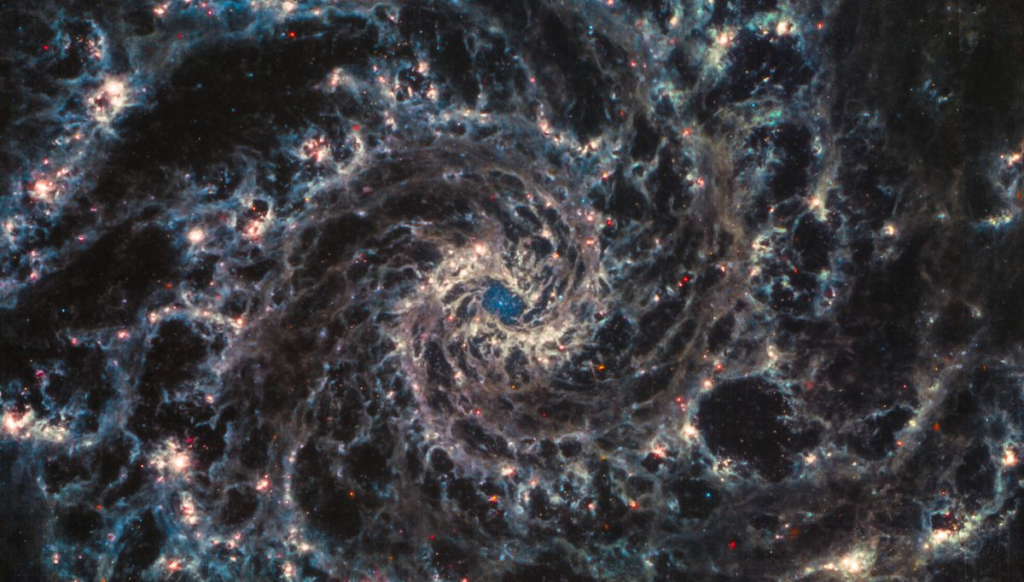Astronomy, the new and the old perspectives, has always been the source of unbelievable news and unusual mysteries. It leaves its followers in awe and amazement with its each novel discovery. The race to find bewildering enigmas of space capacities is constantly in progress. It won’t be wrong if we document the year 2022, as the year of amazing spatial discoveries.
ENCHANTING SPACE IMAGERY
Telescopes used to visualize the atmosphere beyond the boundaries of Earth; see it thoroughly and depict the undistorted imagery of space. The notable amongst them is Hubble Space Telescope.
JWST (James Webb Space Telescope)
The James Webb Space Telescope is the largest and the most powerful telescope which uses complex mechanics to see the panorama of the universe, unveils the spell bounding cosmic mysteries, and manifests the clarion of space imagery.
The distinctive gold-plated JWST has been introduced by Joe Biden, the President of the USA, whose phenomenal development is the joint effort of Canadian and European space agencies in collaboration with NASA. This accounts to be one of the most expensive and complex missions ever introduced in space with a worth of $10 billion. It was neither an easy construction nor so elementary to be installed. Its manufacturing took approximately 20 years, facing multiple setbacks in its operational journey.
The first images and information that beamed back to Earth by JWST proved that the lifelong efforts didn’t go in vain. The astronomers were awestruck by the mindboggling imagery and data received. Those images are just the notions of what is following next.

It is speculated that JWST might renounce all other space telescopes and will prove to be the most authentic source of cosmic data which will fuel thousands of research papers worldwide. In no time and without any doubts it will revolutionize the whole present picture of universe in coming years.
RECENT BREAKTHROUGHS
- The Glimpse of the Most Distant and The Ancient Galaxies
Galaxies, the gigantic assortment of heavenly masses spread across the sky. They have billions of stars, planetary systems, asteroids, comets, meteorites and massive clouds of dust and gases. Our Milky Way galaxy is an enormous array of celestial bodies.
A team of astronomers has reported the recent discovery of some of the earliest galaxies visualized by NASA’s James Webb Space Telescope which are thought to be created 400 million years after the Big Bang. The data collected earlier unveiled some of the records of such faint galaxies but now, with the JWST’s spectroscopic observations, their fingerprints have been confirmed.
11th of July, 2022 is documented as the day of remarkable discovery in the history of space studies. It was a live broadcast from White House when President United States, Joe Biden witnessed the commixture of thousands of galaxies by himself and was overwhelmed at the glimpses.

JWST has provided the pictorial data of the most distant celestial collections in the midst of December 2022. Almost four distant galaxies have been observed by JWST one amongst them is the far off reddish galaxy expected to be 13.8 billion years old-the most ancient one. Researchers speculated that the newly discovered galaxies are extremely beyond the distances they have anticipated before the JWST’s observed data.
- Discovery of Exoplanets
Exoplanets, beyond the borders of our solar system, dwell massive number of colossal planets. They orbit stars other than sun. They might be Gas Giants, Neptunian, Super Earth or terrestrial.
The first exoplanets were discovered in 1990s and today there are over 3000 known planetary bodies orbiting around the stars. Among them only a few have been pictured directly. Most of the exoplanets are so far-flung to be detected easily. But thanks to JWST, in September 2022, the direct image of an exoplanet was captured. Moreover, NASA confirmed the presence of over 5000 exoplanets including super-Earths, gas giants and dwarf planets beyond our solar system. This great discovery has rippled the overall momentum of space studies and astronomy.

- Titan’s Clouds
Images taken by JWST in early November 2022, researchers spotted some exciting floating entities on, probably, the northern hemisphere of Saturn’s alien moon named Titan.
Titan captivates scientists and researchers of astronomy for multiple reasons. Firstly, the intense ultraviolet radiations coming from the sun create a huge buildup of organic molecules in Titan’s nitrogenous and methane-rich atmosphere. This dense and hazy atmosphere obscures its surface drowned in expanded stretches of dunes, along with lakes, rivers and seas of liquid hydrocarbons like ethane and methane. Secondly, the scientists suspect that deep underneath the Titan’s surface, there might be the reservoirs of a salty liquid water ocean, making Titan a habitable for extraterrestrial life.

Clouds on Titan might be a dime a dozen to any casual observer. But to the astronomers, clouds revealed a lot about the atmosphere of Titan. As Titan is the only moon in our solar system to have a dense atmosphere of nitrogen and methane that is stretched about 370 miles (600 kilometers) into the space, 10 times taller than the altitude of Earth’s atmosphere, according to NASA. So, clouds will help a lot to study about not only the atmosphere of Titan but also why Titan has atmosphere which other moons, in the solar system, are devoid of.
These clouds also validate the weather patterns which predict the appearance of clouds in the northern hemisphere of Titan during its summer season, the time when that region is entirely bathed in sunlight.
The year 2022 was the year of ground-breaking explorations and cosmic revelations. It will surely open the massive avenues to the new realms of astonishing astronomical discoveries. It was a just the beginning with the wonder-scope JWST. More is yet to come.
Read more: PROBLEMS INVOLVING INTERSTELLAR COMMUNICATION

Muniba Usman is a high school teacher and teaching trainer by profession. She has a BS (HONS) in Microbiology and a diploma in Textile and Fashion design. She has a strong passion for research, arts, reading and writing. She has written many scientific articles and fiction stories for children.

